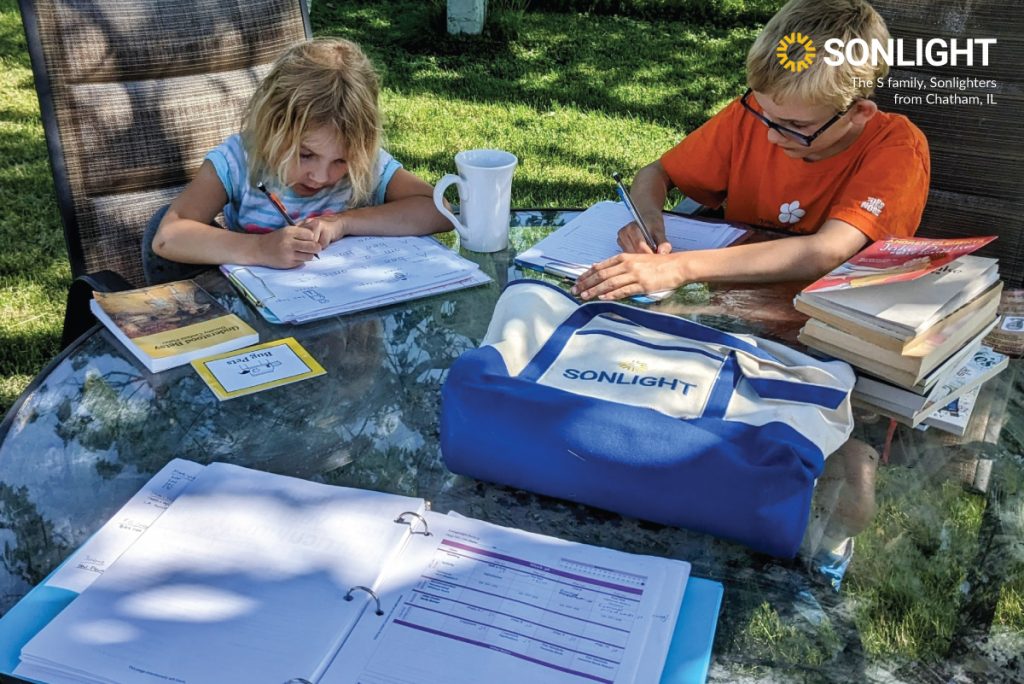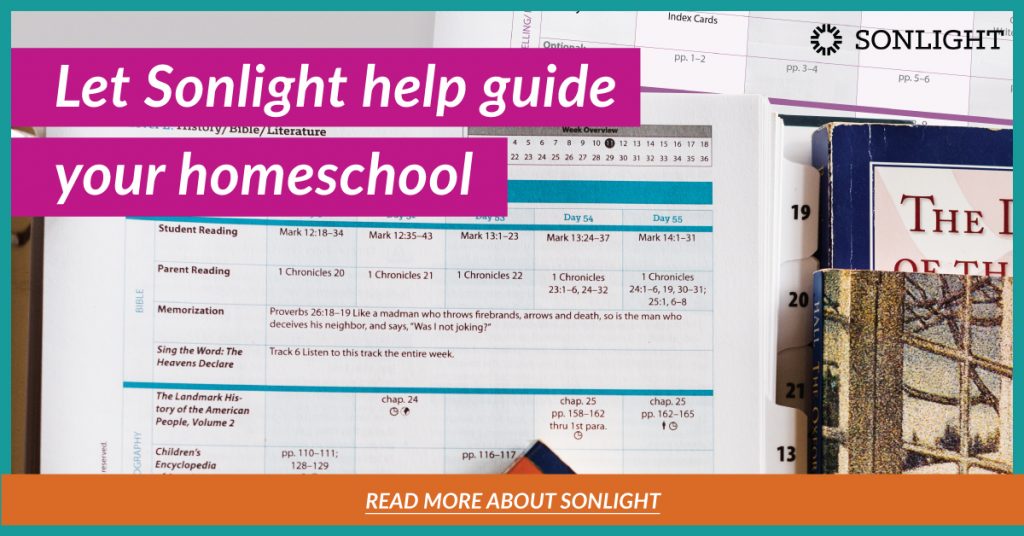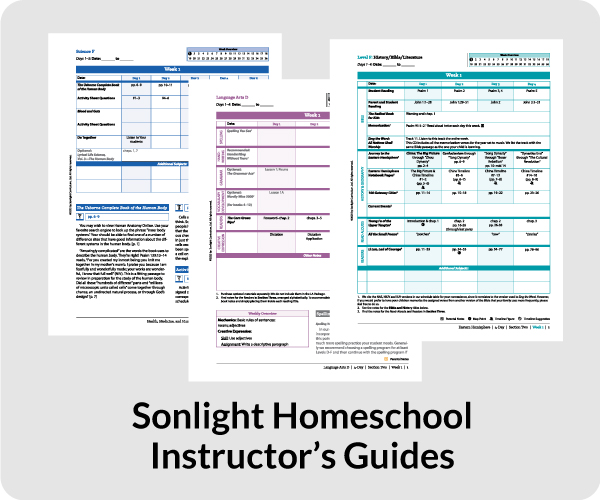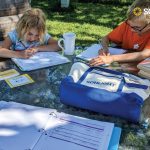When you picture a homeschool day, what does it look like in your imagination? Are you frantically searching for the "good” pencils, trying to remember which lesson you’re on, and not sure which book to read first? Or are you heading into your homeschool day confident and ready? Organization can help you cultivate a peaceful, thriving homeschool whether that's your natural tendency or not. If it doesn't come natural to you, then these 33 ideas, tips, and tricks may help you create a more orderly approach to learning in your home.

Sonlight Makes Homeschool Organization Easy
The idea of organizing can send many homeschool parents into a whirlwind of worry. Don’t fret! Organization does not come naturally to everyone.
The good news: you can learn, and it does get easier to build systems and routines over time.
We asked some veteran Sonlight moms for their best organizational advice and broke down their top tips into 3 categories:
- Sonlight organization (content)
- Time organization
- Physical organization (the ‘stuff’ of homeschooling)
1. How to Organize Your Sonlight Content
Sonlight Homeschool Instructor’s Guides
We at Sonlight know what real-life homeschooling is like, so our Instructor's Guides (IGs) are designed for busy homeschool parents. We’ve heard homeschool moms call their Sonlight IG their homeschool brain. A blessing. A lifeline.
We’ve even heard them joke that Sonlight Instructor’s Guides do everything but make the coffee!
Sonlight curriculum materials will actually help you feel more organized because they are created to be open-and-go. Our program takes the guesswork out of lesson planning. The Instructor’s Guides give you a complete 36-week plan but also allow for flexibility. Everything is broken down step-by-step. However, that big, blue, heavy binder can be overwhelming!
- Lessen the intimidation by pulling schedule pages into a smaller "working" binder. By doing so, you can focus on only what needs to be done that week. When the week is finished, place those pages back into the blue binder and pull out the next week's pages. You can pull one week at a time, three weeks, or even six weeks, but by keeping it smaller, it feels more manageable and doable.
- For those with a large family, use a hanging file folder rolling rack with color-coordinated files for each child to hold the worksheets and workbooks for the week. Completed pages go back into that child's folder for grading and record keeping.
- Play catch-up every six weeks so that you don't get too far behind in any one subject. Don't move past week 6 in the IG until you are caught up in all subjects. By skipping subjects you are "caught up" on, you can double up on those subjects that you're not. This keeps you from getting too far off track at any given time.
- Your IG is your plan for what to do each day, but sometimes kids do well with a planner or a checklist to follow. Use a page protector so kids can use a wet-erase marker to check off what they've completed. You are teaching them a life skill - how to be independent! You can even include chores on the list.
Adapting Instructor Guides to Your Homeschool Style
- While the IG is a key component of your homeschool routine and can help you easily create a daily plan, it is not a rigid taskmaster. You don’t have to do something just because it’s scheduled in your IG or check every box. Skip a book or a writing assignment from time to time if that is helpful. As Jen puts it:
“The homeschool police do not come if you skip something in the IG. Use it as you need it!”
If organization comes naturally for you, you can absolutely fill in dates and create detailed notes. But if your family loves variety, your IG is easy to customize:
- Cross out what you don’t want to do—you’re the boss!
- Break the IG up into more “manageable” pieces.
Remember: the guide is there for you, but it's adaptable, so you can set up your schedule so that it works well for YOU.
Flexing the Sonlight Schedule without Breaking It
- Your Instructor's Guide is designed to be flexible. For families who struggle to get all the work done, follow the four-day schedule, which gives you an extra day to catch up on anything left unfinished.
- Another idea is to use loop or block scheduling. Work in fewer books per day but in larger chunks. This allows for less transitions in a day and keeps students' attentions longer. (For even more information on this topic, check out: 10 Ways Your Instructor’s Guide Can Flex for Your Homeschool.)
- Read while kids are eating. Read Bible at breakfast and read-alouds at lunch. You have a captive audience that way. Also, it keeps the toddler busy while you read.
- Stack the books to read for the week on the table and allow students to pick the order to go in. Then shelve the book when you are finished with the weeks' worth of reading.
Sunny shares:
“With my first child, it was easy to teach Day One as scheduled in the IG. With my second child, I learned to flex the schedule and use it more as a checklist. We often followed the schedule horizontally and read an entire book in one day versus breaking it into daily chapters over the course of the week.”
- Get dad to do several science experiments at once. You have all the supplies out, so knock several out at a time. It's a great way for dads to get involved and gives mom a break.
Getting to all the Books
There are a number of ways to pace Sonlight’s literature-based curriculum.
- If you follow a 4-day school year schedule, but you don't want to miss any of the 5-day books, you can order the extra books and then either work them into the schedule by time period as extra readers (if you have a voracious reader) or as a read aloud (if you don't).
- Another option is to order the 5-day schedule but double up Bible, History, Read Aloud, and Reader, you can get through all the 5-day books in 4 days. (This is not a good idea for people who struggle with staying on top of the schedule.)
- If you find yourself falling behind, save some read-alouds to read in the summer, over breaks, or in the car (use audiobook versions for car trips if you are the one driving). These books reinforce what the student is learning in history and saving some for the summer can help a student remember it better when they aren't distracted by all the other work.
- If a student struggles with reading, then slow the reading pace down and set aside some of the readers to use as summer reading. Summer reading keeps their reading skills up!
“As soon as I switched my mindset from, ‘I have to do all of these,’ to ‘I get to do these,’ my brain was like - Ohh! now I can do it!" - Sunny
- For parents who are doing more than one level, oftentimes the other kids are overhearing what is being read so they are getting even MORE exposure! So, dropping a book or two in that student's level is not the end of the world. They are getting TONS of reading in!
2. Time Organization and Planning Your Homeschool Days
How do you balance teaching multiple children? And what if you also work? Can you still homeschool?
Organizing Your Day When Doing Multiple Levels
- We understand that when you homeschool, finding a way to meet all your kids’ needs and giving age-appropriate help can be a challenge. You need to just start, and by trial and error you will find what works for you, but you must also be willing to adapt as things change.
- Follow your children's natural rhythms. If you have night owls, let them sleep in and focus on the morning people first, realizing that it will make YOUR school day longer, but you will better be able to help your kids if you can spread them out, especially if you have a large age gap.
Jen shares:
“I have two that are night owls, so getting them up first thing in the morning to do school was never going to be productive. But I had two other kids who wanted to work in the morning. So I started with one of them, then kind of worked my way, kid to kid to kid to kid.”
- It might be helpful to remember that if you are a homeschool mom, it's a full-time job. You might be working another full-time job alongside it, but homeschooling IS time consuming. If you realize that, then you won't resent it when it actually does take time.
Can You Combine Working and Homeschooling?
Many of our Sonlight families have found ways to combine working and homeschooling their kids, and perhaps Sunny says it best:
“I work two-and-a-half jobs. I have my real job, I have homeschooling, and then I have my mom job all the time. Moms are never off, really. And so yes, I always say I have two-and-a-half jobs.”
- Yes, it is possible to combine work and homeschooling, but again, the key is to stay flexible with instructor guides, scheduling, and expectations.
- Remember that school doesn’t have to happen just 9 a.m. to 5 p.m., Monday through Friday. You can school early or late and even on the weekends.
- If you have night owls, letting them sleep in allows you to work in the morning, and then you can tackle school in the afternoon and on into the evening. This also allows you to team teach with your spouse. If you have morning people, this won't work for you, and you will need to figure out a different rhythm to your day. Also, every day does not have to look the same.
- Your youngest kids have the least amount that needs to be accomplished. Tackling them first helps to jump start your day! Plus they do not let you ignore them! Their loving cup will be full so that they are more content later in the day because they have spent time with you! Older students have so much more that they can work on their own, so you can catch up with them later in the day.
3. Physical Organization in Your Homeschool
Another aspect of homeschooling that can feel daunting is dealing with all the homeschool stuff - like papers, books, and school supplies - especially if you have multiple kids! As a homeschool parent, you also have your own paperwork to track.
Corralling Paperwork and School Supplies
- Use color-coded magazine holders for paperwork, notebooks, workbooks. They go neatly on the shelves and things don't get lost!
- Give each child their own pencil case to keep their school supplies in if each child likes to have their own (you can color-code these, too! Helps you know who left their stuff out.)
- Alternatively, you can have shared school supplies that are stored in one place (a rolling cart, a caddy, a carousel, a lazy Susan) and are used by all.
- You do NOT need to have a dedicated school room with desks for each child and a dry erase board. You DO need to have a dedicated place to store school supplies.
- Working binders, pencil cases, and Sonlight tote bags make schoolwork portable so you can bring school with you outside, in the car, to the park, the doctor's office, and the soccer field or ballet studio.
Keeping Portfolios
- Some states require you to keep a portfolio - a representation of the student's work for that year - while some do not. Keep what your state requires and toss the rest. You can keep the sampling in a notebook or just put all the papers in a box or a large padded mailer, label it with the year, and then toss the whole thing after the required amount of time has passed.
(Check here to see if this is a requirement in your state).
Organizing all the Books
- If space is limited, store levels in clear plastic bins with lids and only pull out what you are currently using. You can save that level for the next child to use when it comes time. You can store the bin under the bed, in a closet, in a corner of the room, in the basement/shed/garage. A clear bin allows you to see what books are inside without having to open the bin.
- Label book spines with the level that that book is in. You can use labels that Sonlight sells or create your own on a computer. Place strips of packing tape over the label to protect the sticker.
- If space allows, maximize the vertical space and get the tallest bookshelves that will fit in your room. They will hold quite a bit of curriculum! This way you can see them and have access to them.
Can't get enough organizational tips?
For even more tips on how Sonlight makes homeschool organization easy check out the video below where our mentors share their top recommendations!
The Key to Successful Homeschool Organization
Keeping your homeschool organized can feel overwhelming, but the key is to take things one step at a time.
“Just trust the process,” says Johna. “Just do the next thing. Don't worry about what's going to happen in three weeks or in two weeks. You just worry about today, knowing that when you get done with today, there's going to be tomorrow and you're going to do the next thing and it's going to be OK. I promise you.”
This article is a summary of a workshop. If you want to listen to the conversation, then click the video below.
If you are still making curriculum decisions, let Sonlight help you make learning fun in your homeschool by using a literature-based approach.

Having an organized homeschool starts with an organized curriculum. See how Sonlight saves you time and keeps your lesson plans on track.







